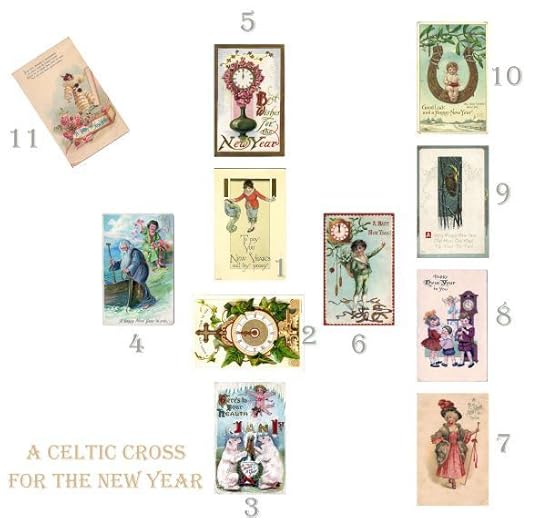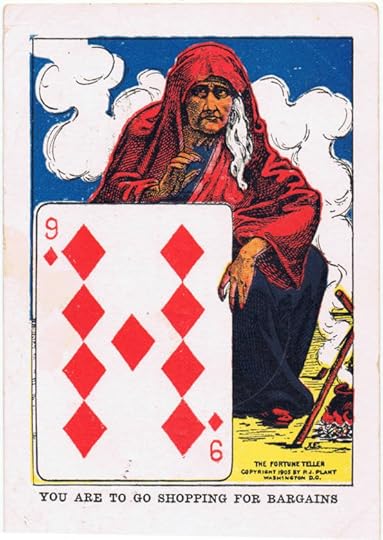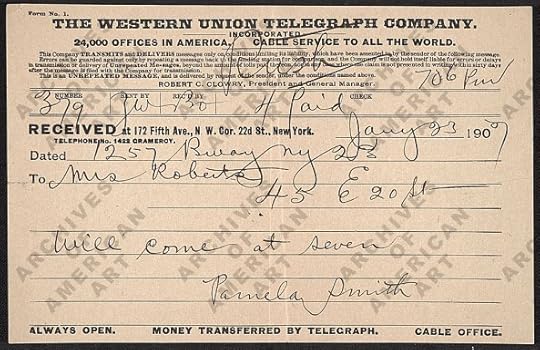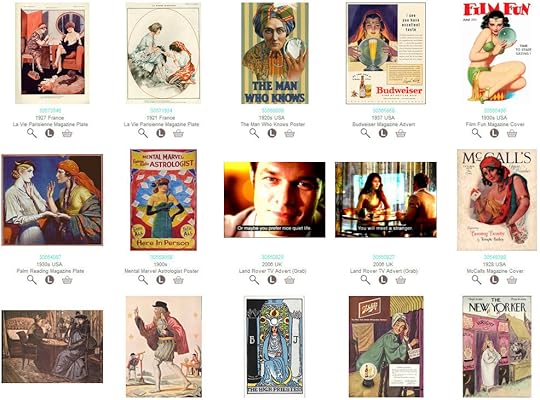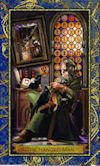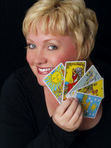Corrine Kenner's Blog, page 11
January 1, 2012
A Celtic Cross for the New Year
Here's a variant of the Celtic Cross I designed to help you look forward to the new year. The spread is based on the traditional Celtic Cross, but the meaning of each position is enhanced by the message of an antique postcard. Simply shuffle your tarot deck, lay out 11 cards according to the diagram, and interpret your cards according to the following descriptions. (You can also click on the image to see it full-size, and print it out scaled to fit a standard sheet of paper.)
"To pay you a New Year's call by proxy." A standard Celtic Cross reading often starts with a significator — a card that signifies the subject of the reading. In this case, the proxy card could represent you — if you're doing a general reading for yourself . Alternately, the card that falls in this position could represent something — or someone — that will pay you a call during the coming year.
"A Happy New Year to You." A crossing card represents the energy and mood of the moment. The card that lands in this position promises to bring you happiness, in one form or another, by midnight tonight.
"Here's to your health." New Year's Day is often a time when we resolve to eat right, exercise more, and improve our health. The card in this position, however, refers to the foundations of good health, and it describes at least one physical strength you already enjoy.
"A Happy New Year to You." The old year and the new cross paths in this timeless illustration. When you shuffle and spread your own deck, the card that lands here will tell you about one important lesson from 2011 that you'll carry into 2012.
"Best Wishes for the New Year." What is your fondest hope for the year to come? What's your most heartfelt desire? Picture it here … but remember to be careful what you wish for!
"A Happy New Year!" A young boy, dressed in green, the color of creativity and growth, greets the year with a beaming smile. He carries a basket of flowers on his back, and he holds an invitation to celebrate good fortune. The card that lands here will illustrate something you'd like to invite into your life this year — and it will show you how well you're prepared to welcome it.
"A Glad New Year Be Thine." In a traditional Celtic Cross spread, this is usually the place where we look for information about self-image. In this vintage postcard, a young woman, dressed in her finest gown, cloak, and hat, stands at attention. She holds a walking stick, which suggests that she's ready to start off on a new adventure. Are you equally prepared for the journey of 2012? The card that lands here will tell you if you're ready.
"Happy New Year to You." Whether you realize it or not, you have an audience. Do the people around you like what they see? Do you delight them? Amuse them? Surprise them? Check the card that falls here to see yourself through their eyes.
"A Very Happy New Year | Oo! Hoo! Oo! Hoo! | To You! To You!" The owl symbolizes our deepest hopes — for wisdom — as well as our darkest fears. Which one are you willing to face head-on this year?
"Good Luck and a Happy New Year. May Good Fortune Favour You." Here you'll find at least one reward you can expect in 2012 — the most likely outcome of the journey you begin today.
We're not done yet. Let's throw a wild card for a sneak peek of at least one joyful surprise you can look forward to this year — and know, as you look at the vintage card in the illustration, that its message is my wish for you this year, too.
Your joys increase a hundredfold
in every year to follow
Cares by so small they can't be told
And all your fears prove hollow.








December 15, 2011
Useful Advice
I don't usually post a card of the day, but in this case, I think I've stumbled across some very useful advice.








December 8, 2011
A Facebook Hiatus
Don't worry. I didn't unfriend you. I just put my Facebook account on hiatus until after the new year. Whew! A little down time is nice, don't you think?








December 6, 2011
A Telegram from Pamela Colman Smith
Look what Google delivered this morning! A telegram from Pamela Colman Smith!
It's dated January 23, 1907. Pamela sent it to her friend Mary Fanton Roberts just to let her know that she'd be stopping by at 7.
Who was Mary Fanton Roberts?
Mary Fanton Roberts was born in Brooklyn, New York in 1864. When she was a young girl her family moved to Deadwood, in the Montana territory, where her father had mining prospects. When she was old enough, she and her sister were sent back to New York to attend the Albany Female Academy. After finishing school, Roberts pursued journalism and became a staff writer for four years for the Herald Tribune, the Journal, and the Sun in New York. During her long career she was editor of Demorest Magazine, editor-in-chief of New Idea Woman's Magazine, managing editor of The Craftsman, and creator and editor of The Touchstone Magazine and Decorative Arts magazine. Her longest period at one publication was seventeen years as editor of Arts and Decoration. She often wrote articles on the topic of decorative arts and home decorating, and published two books,Inside 100 Homes, and 101 Ideas for Successful Interiors.
In 1906 she married William Carman Roberts, writer and editor of Literary Digest for thirty years. They lived in Manhattan and Waterford, Connecticut.
Roberts was very involved in the artistic, theatrical, and literary circles in New York City, and met and became friends with many young avant garde American artists, including Robert Henri and John Sloan. Through her husband she met many writers and poets, including Theodore Dreiser and Bliss Carman. Roberts was active in organizations such as the Women's City Club, Pen and Brush, and the MacDowell Society and also attended countless art openings, theater performances, and other social events. As an avid supporter of modern dance, she became friends with many performers, including Isadora Duncan and Angna Enters. After her husband's death in 1941, Roberts moved to the Chelsea Hotel, where she lived for the rest of her life. She maintained lifelong relationships with a wide circle of friends and continued to correspond with them and attend social events until her death in 1956 at the age of 92.
Image source: http://www.aaa.si.edu/collections/images/detail/western-union-telegram-1907-10208








December 1, 2011
Thin-Shell Structures
Would you like to see a free lecture from Great Courses? Yes, I thought you might. I don't know how it relates to tarot or astrology, but after we watch it we might be able to come up with a few connections.
Aesthetic beauty and structural strength in structures such as St. Paul's Cathedral in London, the Zeiss-Planetarium in Germany, and the Sydney Opera House in Australia come from the same source: the curved shape of their thin shells. While you may think of a thin shell as the epitome of fragility, the truth is that it is astonishingly capable of supporting a tremendous amount of weight. The reason for such strength lies in understanding the engineering science behind a thin shell's very curvature.
In thanks for being our customer, here is a free video lecture: Great Thin-Shell Structures—Strength through Curvature, delivered by Professor Stephen Ressler.
Thin shells—whether made of wood, masonry, steel, plastic, or (most commonly today) concrete—are a unique type of structural element found in some of the modern world's most exciting buildings. The basis for this key architectural element lies in the three different possible shapes of its curved surface: cylinder-like, dome-like, or saddle-like. When subjected to uniform loading, these thin-shell structures are capable of handling extreme loads; much in the same way that an egg, when compressed from all directions, will do the same despite its seemingly weak thinness.
Dr. Ressler is Professor of Civil Engineering at the United States Military Academy at West Point, where he has taught for more than 15 years. A member of the American Society of Civil Engineers, he has been awarded the President's Medal and the Outstanding Projects and Leaders Award. Professor Ressler is also a principal instructor for the Excellence in Civil Engineering Education Teaching Workshop, which has trained more than 500 civil engineering faculty members from more than 200 colleges and universities.
Watch Great Thin-Shell Structures—Strength through Curvature between now and Friday, December 09 to witness the engineering genius that goes into some of the world's greatest structures!
Feel free to send the link to this video lecture to family or friends who might enjoy it; the lecture is free for them as well!








November 16, 2011
First thoughts on the Kindle Fire
 I have a new Kindle Fire! I like it.
I have a new Kindle Fire! I like it.
It's heavier than I expected, which makes it a little unwieldy to hold. At first I thought I could get by without a cover for it — especially since Amazon says it's rugged, so it could theoretically be slipped into a purse or briefcase without damage. For the sake of holding it comfortably, though, I'll definitely have to invest in a book-style cover.
The color screen is gorgeous, and it's a good size for viewing text or video.
The fact that Amazon Prime customers can enjoy free streaming videos was a great surprise. I stumbled across an episode of "King of the Hill" that I like, so that was the first thing I watched. The sound was loud and clear, even without headphones … because I was too excited to find my headphones before I tried it out.
I think the Fire came with a fully charged battery. It worked the minute I pushed the power button. And while I did plug it in, because I thought I should, the ready light changed from amber to green after just a few minutes.
I had no trouble connecting to our wireless network. I also had no trouble connecting to the web.
Everything I've ever purchased from the Kindle store or Audible.com showed up immediately. The interface is pretty slick: the books and magazines look like they're all lined up on a shelf, covers facing out, so you can flip through them in a flash. There were even a few books there that I'd forgotten about, because they're not at the top of my regular Kindle's reading list. It was nice to see all my old friends again.
I like how the screen orients itself instantly, depending on whether you hold it vertically or horizontally. Granted, I have a stupid little cell phone, but I'm used to it being really stubborn about changing directions.
It was surprisingly easy to enter text on the touch screen. Again, I might be easily pleased, because my cell phone is so reluctant to work with me, but it was a relief to find a device that actually accepts my input.
I shopped for an app, too, just to see how that would work. Finding one I wanted — Tropical Skies Astrology – was easy. It downloaded instantly and installed without effort. I really felt like the device was doing all the work for me — which doesn't always happen in the world of computers.
The only thing I haven't tried yet is downloading music. While iTunes has an interface that vexes me, I'm not sure I want to start over with a new Amazon collection. I usually just listen to lectures, classes, and podcasts on my iPod, so I'll probably keep that up for now. After all, I can slip my old iPod into my bra when I just want to walk around listening to something, but the Kindle Fire doesn't nestle well in either cup.








November 14, 2011
I see you have excellent taste
Just for fun, here's a collection of vintage ads that feature fortune tellers. My favorite is the gypsy who sees a Budweiser in your future. (Source)








October 20, 2011
Q&A: An interview with the book
Helen Howell didn't just review my newest book, Tarot and Astrology — she interviewed it! Yes, you read that right. Helen interviewed the book itself.
Before I tell you any more about this book and what I personally think of it, I thought I would ask the Book three interview questions and see what it actually had to say about itself. Now you might say how can a book answer questions? But believe me I have found books are just as clever at answering questions as a tarot deck is!
Click here to read Helen's interview.








September 26, 2011
Audio Book Reviews on Beyond Worlds
[image error]
The team at Beyond Worlds is doing audio reviews of tarot books! Click the "play" button to listen to Angelo Nasio's review of my book, Tarot and Astrology.








September 23, 2011
Happy Anniversary, Neptune!

The planet Neptune, as seen from above its largest moon, Triton. Illustration by Paul Hudson, National Geographic.
Today marks the 165th anniversary of Neptune's discovery in 1846. The beautiful blue planet was mathematically predicted long before it was spotted visually.
These days, Neptune has a prominent position in the study of tarot and astrology. Here's what I wrote about it in my latest book, Tarot and Astrology:
The Hanged Man spends hours—or even days—suspended in a trancelike alternate reality. He is in perfect synch with Neptune, the planet of spiritual and psychic enlightenment.
The Hanged Man's consciousness transcends the physical, just as Neptune itself seems to escape the ordinary bounds of physics. After all, the planet is composed mostly of ethereal mist and gasses. It's a planet of dreamlike illusion, as well as an existence removed from the limitations of physical concerns.
From that vantage point, mystical experiences come easily. Both Neptune and the Hanged Man are associated with fantasy, imagination, and visionary art. They are idealistic, sensitive, and exceptionally psychic.
Neither one is very good at establishing boundaries. The real world can be a dark and dangerous place, and both the Hanged Man and the Neptunian spirit quickly learn to escape through meditation, prayer, sleep, and dreams.
Occasionally, they seek refuge through alcohol and drugs. Sometimes, those substances are a form of self-medication, in an effort to block the unsolicited psychic messages that flood the Neptunian soul.
In a tarot reading, the Hanged Man card often represents a period of willing self-sacrifice and the suspension of everyday cares and concerns. It could suggest a retreat or a change in perspective.
While most versions of the card show the Hanged Man upside-down, he rarely seems to be in any pain or discomfort. Instead, he seems to be tuned in to a higher consciousness—and it's a reward, not a punishment.
In Roman mythology, Neptune was the god of the sea. He ruled the tides and the tide pools, as well as the dark, mysterious world of the ocean's depths. Seas would rise and fall at his command, and he could drown his opponents in an uncontrollable swell of unfathomably violent emotion.
Neptune rules Pisces and the twelfth house of the zodiac, where astrologers look for secrets. It also rules the places where those secrets are confined and locked away: hospitals, prisons, and mental institutions. In medicine, Neptune is associated with mysterious illnesses and neuroses.
The Hanged Man corresponds to the element of water.
The Hanged Man illustration is from the Wizards Tarot by Corrine Kenner and John Blumen.
I found the Neptune illustration here.









